





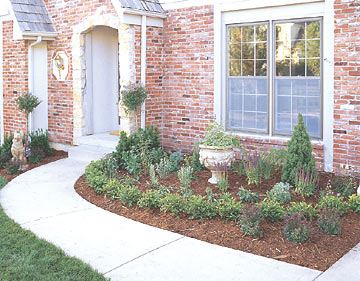 Shown just after planting, this
easy entry garden will be full
and lush within a year.
Shown just after planting, this
easy entry garden will be full
and lush within a year.
Sometimes a simple plan is the best plan. In this case, a perennial garden developed by landscape designer Kristopher Dabner uses common, easy-growing plant varieties to produce an entry garden that is a cinch to take care of and that looks good in all four seasons. Long-blooming perennials such as coreopsis, daylily, and pincushion flower provide color from spring through fall, as well as attractive foliage when not in bloom. Maidengrass and yew provide color and texture into the winter, when the perennials are asleep under the snow.
Before you begin planting, check your soil for a good, crumbly texture (like chocolate cake). If you squeeze a little in your hand, it sticks together somewhat but still crumbles apart easily. Use the guidelines below to improve your soil quality.
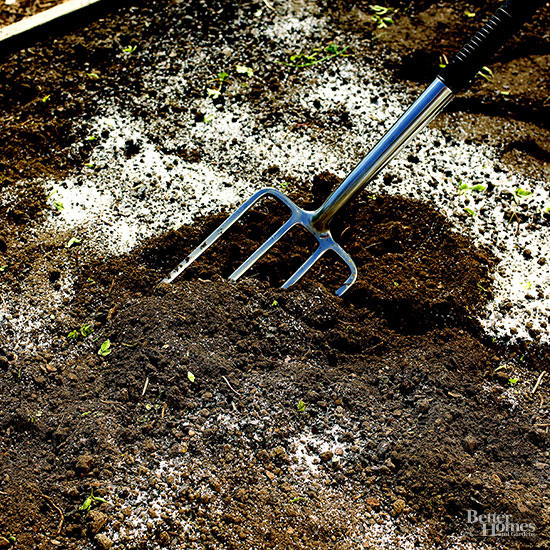
Clay soil: Add as much organic matter -- compost, composted manure, peat moss, or humus -- as you want. Do not add sand alone to clay soils, or you risk creating a concretelike substance. Mix sand with peat moss or compost first and then thoroughly mix into soil. Add organic matter annually.
Sandy or high-silt soil: Blend topsoil with compost or peat moss and add to soil.
Alkaline soil: Mix peat moss or oak leaf mold into planting beds to gently lower the pH. Or mix soil sulfur into the ground for a faster effect. Some plants, such as azaleas, rhododendrons, camellias, and blueberries, need acidic soil.
Test Garden Tip: Add organic matter to soil before planting. Dabner prefers locally available compost, such as that made by garden centers or private firms. To find a source in your area, look in the Yellow Pages under "Recycling."
Create your own compost.
Make an attractive screen for your compost bin.
Although designed for the Kansas City, Missouri, area (Zone 5), most of the plants here will thrive throughout most of the United States. For best results, plant in full sun; most of the plants will also perform well in partial shade. To ensure good results in your area, purchase plants from local garden centers, substituting similar plants for those varieties not well suited to your Zone.
The main portion of the plan measures approximately 28 feet across by 20 feet deep, but the garden could easily be expanded or reduced by altering the number of each type of plant.
See below for a planting diagram and plant materials.
USDA Plant Hardiness Zone Map
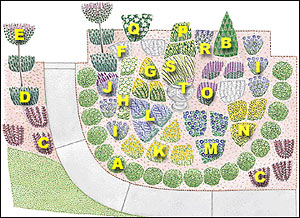
A. 'Winter Gem' boxwood
B. Dwarf Alberta spruce
C. 'Crimson Pygmy' barberry
D. 'Hicks' yew
E. Korean lilac standards
F. 'Powis Castle' artemisia
G. 'Golden Fleece' goldenrod
H. 'Becky' Shasta daisy
I. 'Butterfly Blue' pincushion flower
J. Butterfly bush
K. Coreopsis
L. 'Little Spire' Russian sage
M. Stoke's aster
N. 'Goldsturm' black-eyed Susan
O. 'May Night' salvia
P. 'Happy Returns' daylily
Q. 'Blue River II' hibiscus
R. 'Purple Smoke' baptisia
S. 'Gracillimus' maidengrass
T. Assorted annuals
Be maintenance-minded. For an easy-care garden, select plants that don't demand daily attention. In this garden, Dabner chose shrubs that don't require heavy pruning. Annual trimming keeps the boxwoods tidy; twice-yearly snipping holds the yews in check. Shape the lilac standards flanking the front door annually, right after bloom. Perennials need to be deadheaded as flowers fade; in fall or early spring, cut old growth back to a few inches from the ground.
Discover shrubs with fantastic foliage.
See top shrubs for summer blooms.
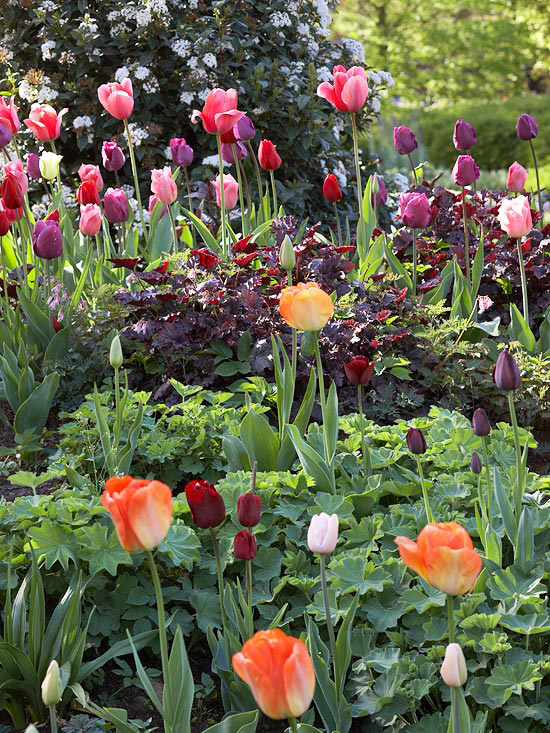
Stage the seasons. Plant bulbs in the autumn for spring blooms. Create seasonal flair by choosing bulbs in shades of blue, pink, and white; then changing the color scheme of your yard with bold red, yellow, and orange flowers in summer.
Use evergreens and structural objects, such as an urn, to maintain visual interest through winter. They're particularly effective in landscapes that experience snowy winters.
Measure up. Carefully consider the size of the space you have and how much you can reasonably fit. Remember that you need access to plants for trimming and deadheading.
Get tips for designing with spring-blooming bulbs.
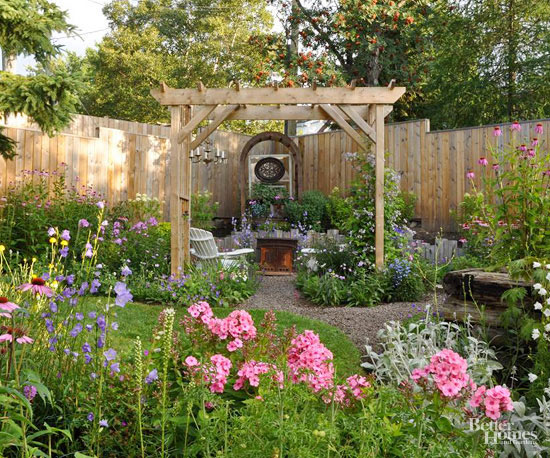
Shop smart. Plan your front-yard makeover in phases; do one bed, then another in the following season or year to reduce costs. Dabner suggests making a plant shopping list and sticking to it. "When you have a list, you can shop at hardware and home improvement stores successfully. Try to buy plants when they're fresh off the truck for best quality," he says. He also urges getting plant starts from neighbors. "It's a way to make friends and get helpful advice about what grows best in your area!"
Whether you're staging an entry area or a secluded backyard getaway, your garden needs a focus -- something that's eye-catching and draws guests into your escape. Keep durability and maintenance in mind when selecting objects. Stone is the longest-lasting choice; iron lasts but can rust if not treated. Painted objects will fade and eventually peel, and terra-cotta can crack and crumble if exposed to wintry conditions.
Containers, sculptural elements, furnishings such as a bench or chair, water gardens, and petal-packed flowers can all play the role of garden star. Select your favorite element and make it the point of your patch.
Copyright © www.100flowers.win Botanic Garden All Rights Reserved